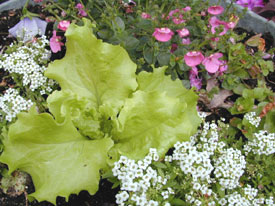
Many types of peppers thrive in containers.
Now is the time to plant crops for bountiful harvests this summer and fall. Even small-space gardeners can grow enough nutritious produce to prepare a few meals, supplement your diet, and save some bucks. With a little planning and attention, container gardens can produce like mini farms.
Almost any vessel can be used as a container, but it must have drainage holes that allow water to freely flow through the pot. Most veggies only need about 6 inches of soil depth. Trays and smaller containers work fine for lettuce, radishes, spinach, and peppers. Root crops like carrots and onions, and large plants like most tomatoes and squash, require half-barrels, grow bags, or some other large (larger than 16 inches in diameter) container. As a general rule, bigger is better for root growth and overall vigor.
When growing veggies in containers, packaged potting mixes are typically the best choice. Using garden soil in containers is never ideal. In urban areas where there is a potential for contamination, filling a container for edibles with city dirt is out of the question. Packaged potting mixes are lightweight, moisture retentive, and well aerated. Plus they do not harbor any fungi, bacteria, insects, or weed seeds that would cause problems later.
Sunlight — not space — is probably the biggest limiting factor in urban environments. Without at least six hours of sun a day, it's going to be tough to grow quality veggies. Crops need a lot of solar energy to make nutritious fruits, seeds, and leaves. Southern exposure is best, but six hours from any direction should be sufficient. To avoid leaning or uneven growth, rotate the containers weekly.
Wind exposure is another factor to consider. To prevent desiccation and damage from the wind tunnel effect, urban gardeners should place large plants in sheltered locations. Avoid narrow alleys or any other spots where wind is funneled directly towards the plants. If the only options are exposed balconies and terraces, use wire cages or other sturdy supports to protect large plants like tomatoes, beans, peas, and squash.

Mix veggies and flowers for an ornamental edible garden in a pot.
Regular watering is crucial when you grow in containers because there's limited soil mass for storing water. During the peak of summer heat, gardeners may need to water daily to keep plants growing at full potential. A drip irrigation system allows you to water automatically, and with a timer you can even water containers when you're away. However, the best option for vacation watering is always a reliable neighbor. (And if they happen to be a master gardener, then your karma’s working overtime!)
Vegetables grown in containers also need regular fertilizing. Follow the label instructions and make sure the container is well drained or plants may suffer from high salt levels due to fertilizer buildup. Some gardeners combine the two tasks and simply water with a quarter-strength fertilizer solution once a week.
If plants don't appear vigorous and healthy, check them closely because disease and pest infestations can quickly get out of hand. If caught early, most are easy to treat. Check the undersides of leaves for insects. Many of them can be picked off or sprayed off with a strong stream of water. Some pests require other treatments. Natural insecticides and biological controls (ladybugs, parasitic wasps, predatory midges, etc.) are very popular with home gardeners. Always read the label to make sure the product is compatible with food crops, and follow the directions carefully.

Try growing grape tomatoes in a half-barrel with bamboo stakes for support.
When selecting plants, look for vigorous young seedlings with bushy growth.
Plants that are lanky or already flowering are not good choices. Check
to make sure each seedling is securely anchored in the six-pack or pot, which
implies a well-established root system. Dip the seedling in a bucket of
water
to moisten the rootball, tease out any circling roots, and plant it at
the same depth it was previously growing. (Tomatoes are an exception because
they can be planted with the bare stem several inches below the ground
and
roots will form along the stem.)
Some crops, like lettuce, beets, and carrots, are best grown from seed.
Simply follow the instructions on the packet. Be sure to thin sprouts to
the recommended
spacing. Thinning is a ruthless task, but fortunately most veggie sprouts
can be used in salads and other dishes for an early-season treat.
The crops and varieties listed below are good choices for containers. Because of the rising popularity of container gardening, many more options are appearing every year. Check your local garden centers, farmers’ markets, and botanic gardens for the newest varieties.
For more info, check out the following NGA articles and visit Edible Landscaping with Charlie Nardozzi.
Starting Your Container Garden